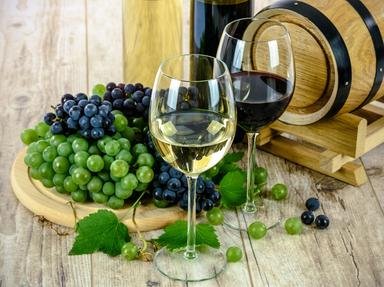Quiz Answer Key and Fun Facts
1. Assmannhausen (AHS-mahn-how-zehn) is a village in the Riesling rich Rheingau (rine-gow) region. In Assmannhausen, they're different. They make red wine from a grape called "Spätburgunder" (shpayt-buh-guhn-duh). It's called something else on Burgundy's Cote d'Or and in the Willamette Valley in Oregon,USA. What is the better known name of Spätburgunder?
2. Germany has a white wine grape that has been around even longer than Riesling. It's regaining popularity as the Germans drink more dry wines. Its distinctive name makes it look like the grape comes from a verdant forest region. Can you find our "green forest" grape?
3. Blaufränkisch (which sounds like it's spelled) is a red wine grape whose name means 'Frankish blue'. It has another name, too. Seldom used in Germany, the grape is called by this second name in the American Northwest. The name looks and sounds like a notoriously stinky cheese. Can you sniff out Blaufränkisch's other name?
4. A white wine grape the Germans borrowed is used to make mostly dry wines. In German it is called Grauburgunder. "Burgunder" means from Burgundy in German, and usually refers to the pinot grape clan. This particular pinot has come to be more associated with northern Italy than Burgundy. Can you find the right pinot?
5. The Germans are among the world's most avid crossbreeders of wine grapes. In the 1950s the viticulture school at Weinsburg developed a high quality red wine grape that is rapidly gaining popularity. Its name means "from the thornfield" and looks like it might trace back to the family of Star Trek the Next Generation actor Michael ______, who played a Klingon. Can you find this newer grape?
6. Liebfraumilch, is a pleasant if undistinguished white wine that has introduced many people to German wine. The functional translation is "Our Lady's Milk". The name is derived from the Liebfrauenstift vineyard in Worms. The vineyard is only about one kilometer/0.6 mile from the great River that is the traditional artery through which the wine of Germany flowed. Name the river.
7. The Baden wine region in southern Germany produces a delicate rose wine so pale it is called Weissherbst or "white autumn". There are other places that make these very, very pale pink wines, which carry a French name that means "grey wine". What would Weissherbst be called in the rest of the world?
8. Germany produces sparkling wine,too. The most common on the world market is Sekt (zekt). Most of it is perfectly decent bulk process sparkling wine. Less than 10% is held to much higher standards, either made much like Champagne,and from the same suite of grapes, or based on a single German grape. Which German grape?
9. Riesling is the elephant in the room when we speak of German wine. Elephants can live up to 80 years. While many people adore fresh, young Riesling, our question is can Riesling age well? Respect the pachyderm!
10. The great Riesling dessert wines of Germany are justly legendary. They share a common bond with Sauternes from Bordeaux and Tokaji Essensia from Hungary. These great wines need the presence of a microbe that is only sometimes beneficial. The Germans call it "Edelfäule", the French "pourriture noble". What is it called in English?
Source: Author
Jdeanflpa
This quiz was reviewed by FunTrivia editor
WesleyCrusher before going online.
Any errors found in FunTrivia content are routinely corrected through our feedback system.
